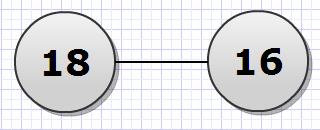
| Online Judge | Online Exercise | Online Teaching | Online Contests | Exercise Author |
|
F.A.Q Hand In Hand Online Acmers |
Best Coder beta VIP | STD Contests DIY | Web-DIY beta |
Sequence Folding
Time Limit: 2000/1000 MS (Java/Others) Memory Limit: 32768/32768 K (Java/Others)Total Submission(s): 423 Accepted Submission(s): 235
Problem Description
Alice and Bob are practicing hard for the new ICPC season. They hold many private contests where only the two of them compete against each other. They almost have identical knowledge and skills, the matter which results many times in ties in both the number of problems solved and in time penalty! To break the tie, Alice and Bob invented a tie breaker technique called sequence folding! The following are the steps of this technique:
1- Generate a random integer N >= 2.
2- Generate a sequence of N random integers.
3- If N = 2 go to step 6.
4- Fold the sequence by adding the Nth element to the first, the N-1th element to the second and so on, if N is odd then the middle element is added to itself, figure 1 illustrates the folding process.
5- Set N = ceil (N/2) and go to step 3.
6- The sequence now contains two numbers, if the first is greater than the second then Alice wins, otherwise Bob wins.

Figure 1.a Before Folding

Figure 1.b After one step of folding

Figure 1.c After two steps of folding, Alice wins!
In this problem you¡¯re given the sequence of N integers and are asked determine the contest winner using the sequence folding tie breaker technique.
1- Generate a random integer N >= 2.
2- Generate a sequence of N random integers.
3- If N = 2 go to step 6.
4- Fold the sequence by adding the Nth element to the first, the N-1th element to the second and so on, if N is odd then the middle element is added to itself, figure 1 illustrates the folding process.
5- Set N = ceil (N/2) and go to step 3.
6- The sequence now contains two numbers, if the first is greater than the second then Alice wins, otherwise Bob wins.



In this problem you¡¯re given the sequence of N integers and are asked determine the contest winner using the sequence folding tie breaker technique.
Input
The first line contains T (1 <= T <= 100), the number of test cases. The first line of each test case contains an integer (2 <= N <= 100), the number of elements of the sequence. The next line contains N space separated integers. The sum of any subset of the numbers fit in a 32 bit signed integer.
Output
For each test case print the name of the winner. Follow the output format below.
Sample Input
2 5 2 5 10 3 -4 3 5 4 -3
Sample Output
Case #1: Alice Case #2: Bob
Source
| Home | Top |
Hangzhou Dianzi University Online Judge 3.0 Copyright © 2005-2024 HDU ACM Team. All Rights Reserved. Designer & Developer : Wang Rongtao LinLe GaoJie GanLu Total 0.000000(s) query 1, Server time : 2024-11-22 21:54:34, Gzip enabled |
Administration |